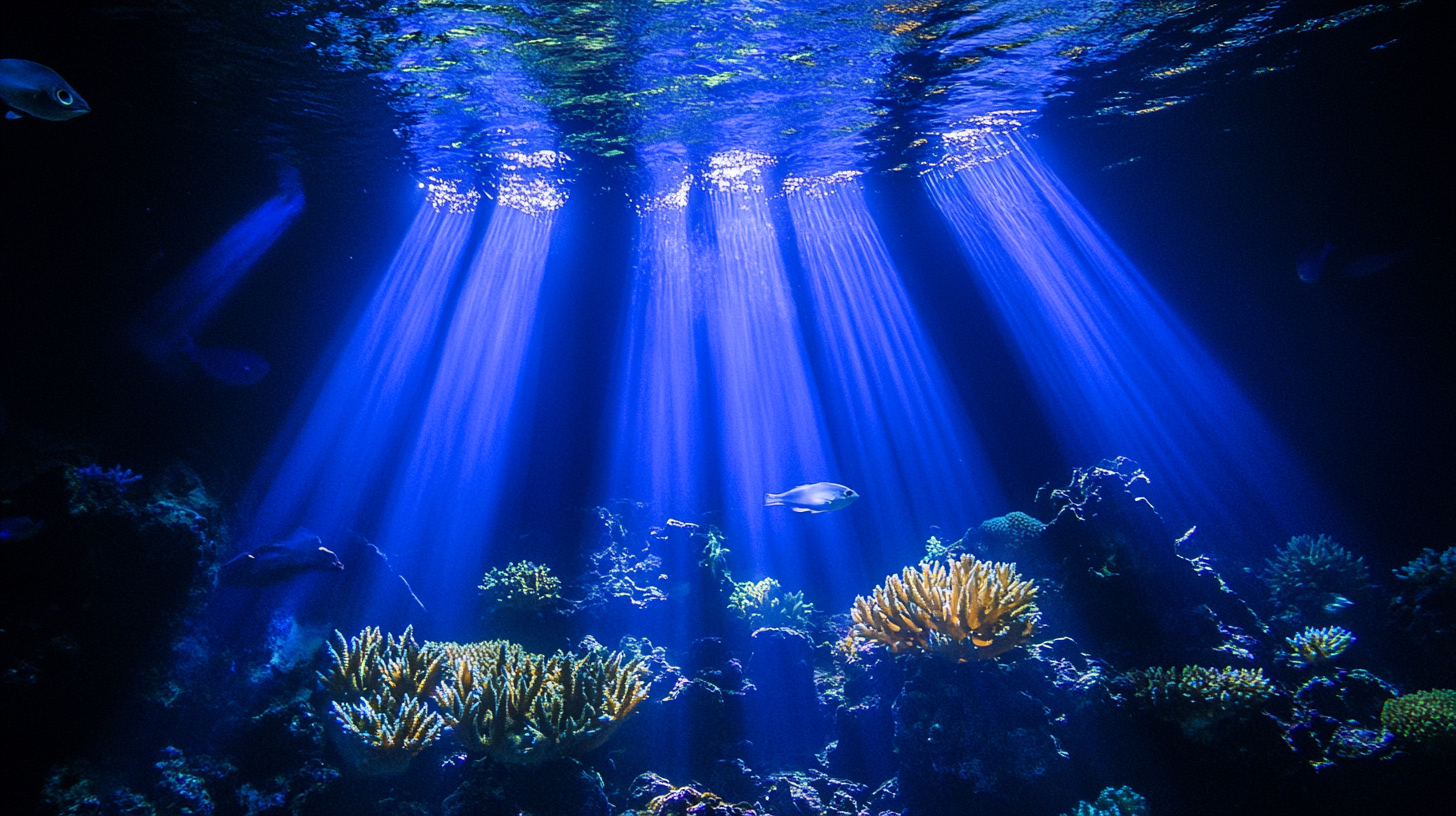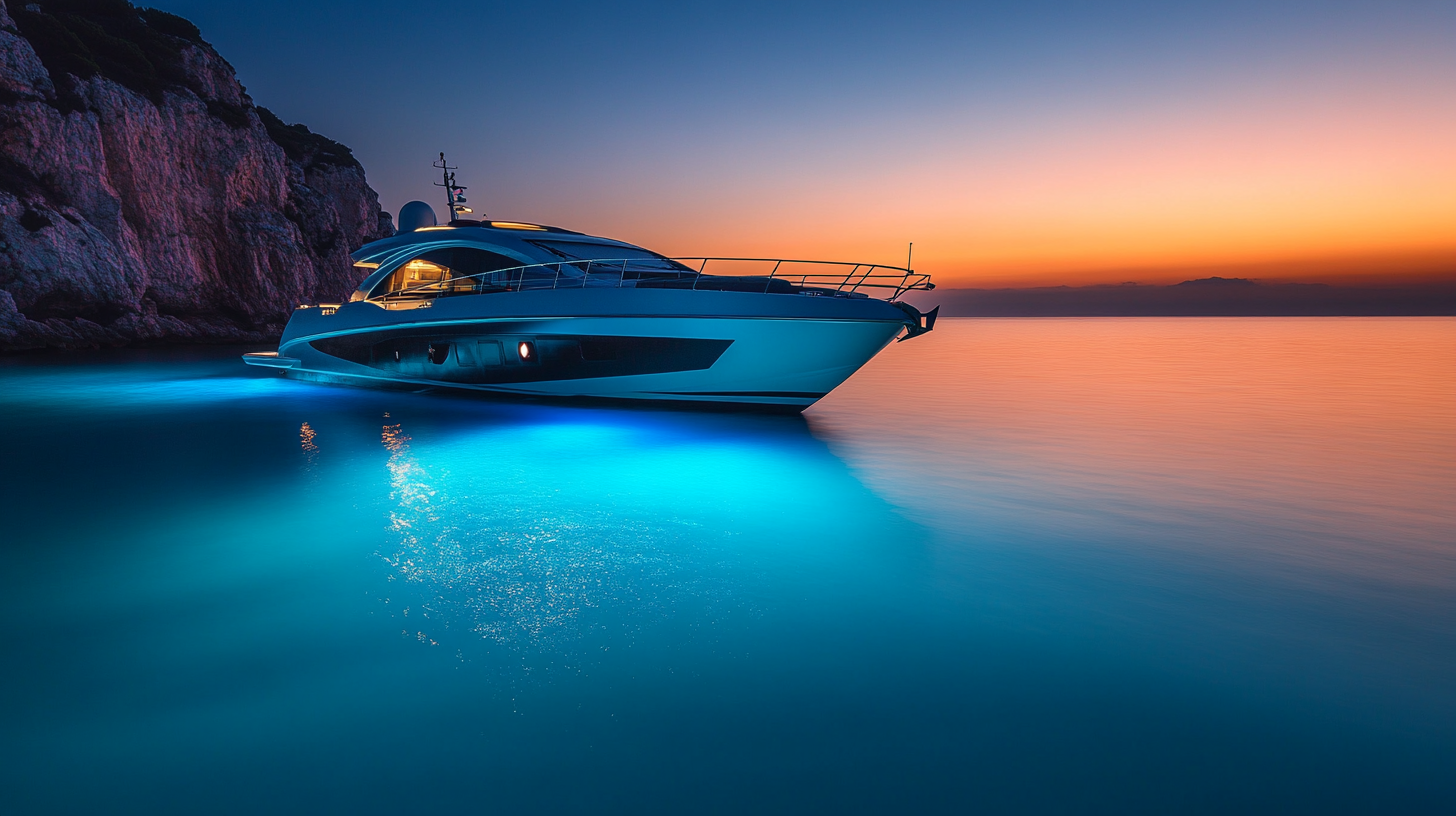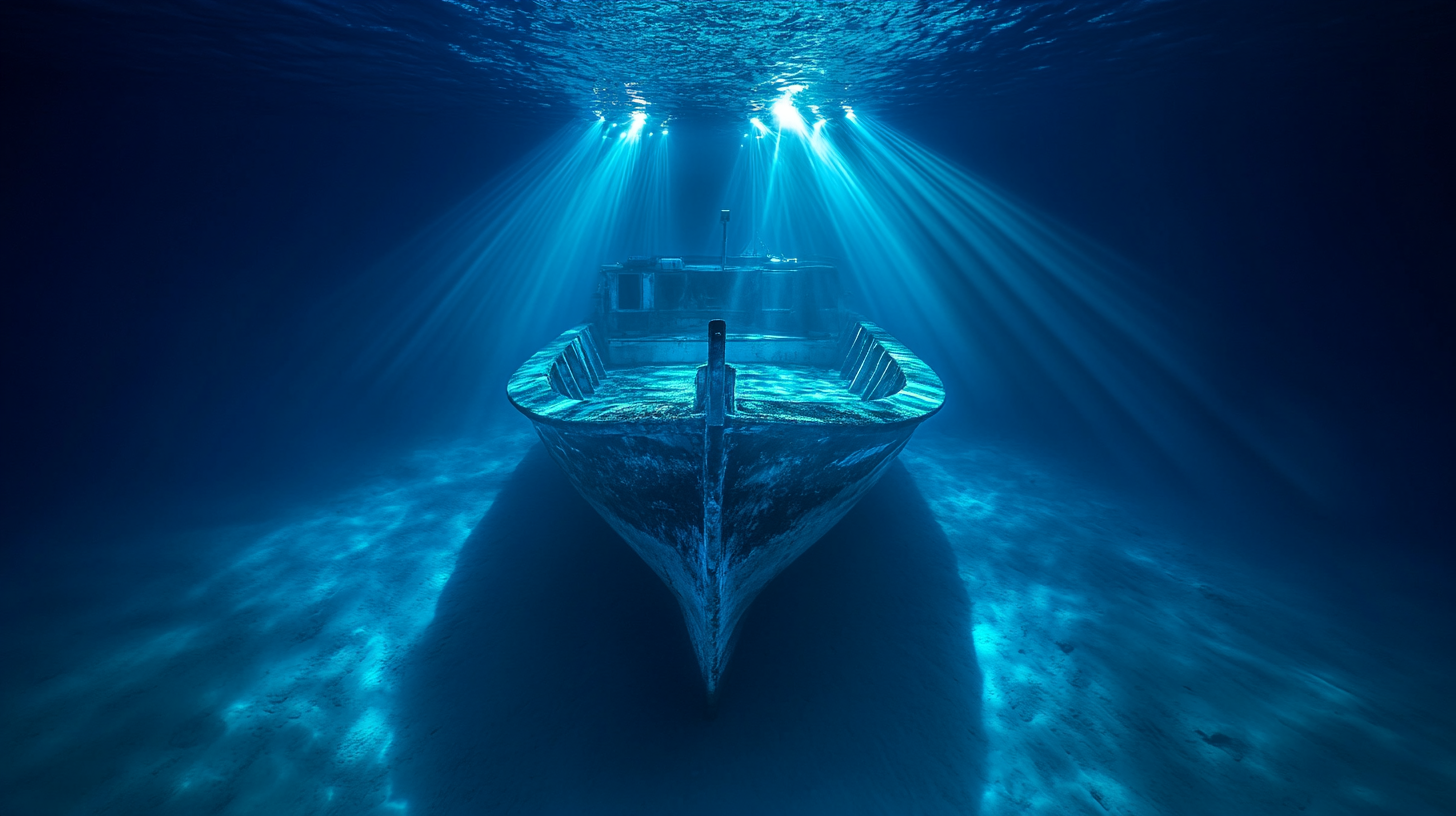The role of underwater boat lights in underwater photography
One of the primary roles of underwater boat lights in underwater photography is to enhance visibility, helping you to capture clear, vivid shots even in deep or murky waters. Whether you’re shooting in crystal-clear tropical waters or exploring darker, more challenging environments, underwater lighting plays a crucial role in ensuring your photos are sharp and detailed.
Water reduces light penetration and scatters particles, which can make it difficult to get well-lit subjects, especially as you descend. Boat lights help to counteract this by cutting through the water’s natural darkness, illuminating everything in their vicinity, and drastically improving the sharpness and clarity of your images.
These lights can also help reduce backscatter – the annoying, tiny particles that show up in your photos when your camera’s flash reflects against floating debris. By positioning the lights strategically, boat lights provide the necessary lighting from various angles, minimizing direct beams and avoiding harsh shadows or glare on your subjects.
For photographers aiming to highlight textures, colors, and even critters hiding in crevices, a well-lit underwater environment can make all the difference. This is especially true in deeper settings where natural light doesn’t reach, and every little bit of artificial illumination matters. The visibility offered by underwater boat lights allows you to focus your lens on intricate details, capturing shots that would otherwise be hidden in darkness or fuzzy from the lack of proper lighting.
Creating artistic lighting effects
In addition to improving visibility, underwater boat lights open up endless creative possibilities for the artistic side of underwater photography. By experimenting with the angles, colors, and intensity of these lights, photographers can achieve striking visual effects that transform a simple underwater scene into a captivating work of art.
Colored lights are particularly popular among underwater photographers. They can be used to manipulate the mood and atmosphere of an image. For example, blue lighting can evoke a serene or even mysterious ambiance, while green or red lights can create a sense of otherworldly beauty. The use of colored lights also helps to highlight specific elements within the environment, such as illuminating a school of fish with soft white light while bathing the background rocks in a wash of deep cobalt blue.
Positioning the lights at creative angles can also give you more control over how shadows play in your frame. Instead of frontally illuminating your subject as many divers might do, applying light from an oblique angle can enhance the depth and texture of subjects like coral reefs, sand ripples, or a shipwreck. This technique also brings out the contours of marine life such as stingrays or sharks, allowing you to capture their majestic form with dramatic, high-contrast lighting.
Another trick is using a combination of low-light and spotlighting. By keeping the overall environment dim while focusing a tight beam of light on a specific subject, photographers can create a spotlight effect. The surrounding darkness turns the spotlight subject into the sole focus of the image, achieving a minimalistic yet powerful composition. It’s a technique frequently used to isolate a vibrant fish or intricate coral from its surroundings, making it stand out against the backdrop of the deep blue water.
For even more artistic flair, photographers can experiment with reflections and refractions, especially when there is a surface nearby, such as the bottom of the boat or an air bubble. The play of light across reflective surfaces can create mesmerizing ripple effects, lending a dynamic sense of motion to your shots. These patterns can add an abstract quality to your photos, enhancing their visual appeal while simultaneously conveying the fluidity of the underwater world around you.
Ultimately, the role of underwater lighting in photography isn’t just functional—it’s a pivotal tool for telling stories and sparking emotions. With a bit of imagination, underwater lights allow photographers to go beyond simply documenting marine life—they can use light as a brush to paint their unique vision of the vibrant and mysterious landscapes hidden beneath the surface.
Attracting marine life for dynamic scenes
One of the most fascinating applications of underwater boat lights in underwater photography is their ability to attract marine life, giving photographers the chance to capture dynamic, action-filled scenes. Marine creatures, from large schools of fish to shy, nocturnal predators, are often attracted to light, especially in the otherwise shadowy depths of the ocean. This creates unparalleled opportunities for photographers to document the raw beauty of underwater wildlife in motion. By leveraging this natural attraction, you can turn an empty patch of ocean into a bustling underwater stage teeming with life.
In darkness or low-light settings, many marine species are drawn to artificial lights, as the illumination often brings smaller organisms—plankton, shrimp, and other micro life—that serve as food sources for larger creatures. This can create a fascinating food chain right before the photographer’s lens. For instance, illuminating the water just under your boat as you settle in for a night dive can draw in a mixture of these microorganisms, which in turn attract small fish. From there, the predator-prey relationship plays out, with larger fish or even squids swooping in to feed on the creatures gathered around the light.
What makes this truly special from a photography standpoint is the chance to photograph a wide array of underwater life in quick succession—all brought together by the shimmer of the boat lights. With the right setup and timing, your camera can capture these feeding frenzies in dynamic action, showcasing vivid interactions that would otherwise be difficult to witness, much less photograph. This technique is particularly appealing when photographing nocturnal predators like sharks or dolphins, whose movements and hunting behaviors can be dramatically highlighted under the glow of underwater lighting.
Moreover, boat lights can serve as a beacon for mesmerizing creatures like jellyfish, which seem to glide elegantly towards the glow. The soft, undulating movements of jellyfish juxtaposed against the brilliant halo of light create stunning visual contrasts, making for dreamlike, ethereal underwater photos. Their translucent bodies, when lit properly, can refract and reflect light in captivating ways, giving them an almost otherworldly appearance—a photographer’s dream for creating unique, stand-out images.
Some underwater species are inherently more photogenic when illuminated by certain types of lighting. For example, many fish and invertebrates boast bio-luminescent or reflective scales, which shimmer and dance under artificial lights. The boat lights not only allow you to see them more clearly but also help to bring out their vibrant colors and patterns, which might be invisible without proper lighting at greater depths. This adds a layer of complexity and excitement to underwater photography, where you’re not just capturing static images but playing with real-time interactions between light and nature.
The role of underwater lighting as a tool to attract marine life also enables photographers to capture shots that convey the untamed beauty of the ocean’s ecosystem. These scenes are filled with movement, creating a natural sense of drama, whether you’re photographing a graceful manta ray gliding through the illuminated water or a school of fish scattering in different directions as a predator streaks into view. Whatever unfolds, the boat lights set the stage, acting as the curtain call for marine life to perform.
Types of underwater lights and their uses
There are several types of underwater boat lights, each serving a unique purpose depending on the photographer’s needs and the environment in which they are shooting. The choice of lights is influenced by factors such as water depth, the available natural light, the type of marine life you intend to capture, and the desired visual effects.
Broadly speaking, underwater boat lights can be categorized into three main types: floodlights, spotlights, and colored lights. Each of these plays a distinctive role in underwater photography.
Floodlights are widely used by underwater photographers who want to illuminate large areas of water. These lights emit a wide beam, often up to 120 degrees, bathing the environment in light and offering consistent illumination across a broad spectrum of the scene. Floodlights are particularly useful when you want to capture extensive underwater landscapes or large schools of fish, as they evenly disperse light over wide areas, reducing harsh shadows and creating a more natural look in the images. Because of their versatility, floodlights are great in both shallow waters where ambient light is available and in deeper environments where natural light is limited.
However, one common drawback of floodlights in certain conditions is their tendency to create backscatter in water with a high concentration of debris or plankton. The wide beam of light may illuminate these particles, resulting in tiny reflections that can obscure the main subject. Thus, it’s crucial to ensure that the water clarity is favorable when using floodlights.
On the other hand, spotlights are the preferred option for photographers aiming to draw attention to a specific subject. These lights focus on a narrow beam that can range between 30 and 45 degrees, allowing for a concentrated, intense burst of light on a localized area. Spotlights are perfect for isolating a particular marine creature, piece of coral, or underwater formation, making it stand out in contrast to a darker, less illuminated background. Due to their focused nature, spotlights are also beneficial when shooting in deeper waters or at night, where all other sources of light are absent.
Photographers looking to create an atmosphere of intrigue and mystery often opt for spotlights to cast shadows that highlight the texture and dimension of underwater structures or animals. These lights are invaluable for achieving artistic effects when working with more complex compositions, particularly in situations where photographers desire control over shadows and light diffusion.
Additionally, for those looking to go beyond traditional white light, colored lights offer an exciting and creative option. Red, blue, green, and even purple lights allow photographers to manipulate the mood of a shot, add unique accents, or highlight specific subjects against the natural tones of the ocean. In particular, red light is often favored because it penetrates the water less deeply than blue or green light, which minimizes disturbing the marine life—making it possible to get closer to shy or easily startled creatures without affecting their behavior too much.
Moreover, red lighting preserves the natural colors of close-up subjects since the water naturally filters out red light at greater depths. Thus, using red lights can help retain the accuracy of the subject’s appearance without relying on post-processing for color correction. Blue and green lights are equally useful for setting a surreal atmosphere, especially when combined with various types of marine life that reflect or absorb the light in interesting ways. Some underwater species possess bioluminescent qualities that become especially vivid when exposed to colored lighting, opening up another layer of creativity in how underwater boat lights can be used to enhance photography.
For more technical usage, many photographers also rely on strobe lights or video lights fitted alongside boat panels. Strobe lights are synchronized with your camera for intense, short bursts of luminosity that freeze motion, enabling you to capture fast-moving animals with precision and clarity. Video lights, on the other hand, offer steady light output suitable for those blending still photography with motion capture in their work.
The right combination of underwater boat lights ultimately depends on the storytelling needs of the photographer. For someone photographing expansive coral reefs or a gentle sea turtle gliding through the open ocean, floodlights would be the go-to option. However, if the goal is capturing the sharp details and dramatic silhouette of a predator shark lurking near the ocean floor during a night dive, a focused, intense spotlight paired with a color light for background effects may be ideal.
Each type of light plays a critical role in not only making the underwater environment more visible but also in providing photographers with the tools needed to creatively express themselves by shaping and controlling light underwater. Whether you’re combining flood and spotlights for dynamic range or adding a subtle pop of color, selecting the right combination of underwater boat lights is key to producing remarkable underwater photography.
Best practices for using underwater lights in photography
When it comes to achieving the best results with underwater boat lights in underwater photography, knowing how to use them effectively is crucial. While simply shining a light can certainly brighten up your scene, strategically using artificial lighting can elevate your images from average snapshots to breathtaking works of art. Whether you’re a seasoned professional or a beginner experimenting with light underwater for the first time, here are some key best practices to keep in mind.
First and foremost, positioning your lights correctly is essential. Underwater lighting can create dramatic differences depending on where it’s placed relative to your subject. Lights positioned too close to the camera often result in “flat” lighting, where shadows are minimized and the subject loses depth and dimension. Instead, try placing the lights off to the side or slightly behind the subject to highlight shapes and textures, creating a more three-dimensional look. Angled lighting, especially when targeting rocky landscapes or marine creatures, enhances the contours and reveals details that would otherwise be lost in direct light. Experiment with different positions to see how the shadows and highlights interplay with each other to provide interesting variations in your compositions.
Another major aspect to consider is the intensity of the lights. Using lights that are too bright could potentially wash out the subject, especially in shallow waters where ambient light is stronger. Conversely, lights that are too dim may result in under-exposed images where key details are lost in the shadows. The goal is to balance artificial light with the natural light available, creating a harmonious image that looks well-lit but still natural. Many underwater photographers use adjustable lights so that they have control over the amount of illumination, enhancing flexibility as conditions change throughout the dive.
Additionally, when photographing at night or in deeper waters, attention should be paid to the color temperature of the lights being used. Water absorbs red light first, followed by orange, yellow, and so on, as you dive deeper—leaving blues and greens to dominate the scene. However, by using underwater boat lights that replicate the warmer tones (such as yellow or red filters), photographers can bring back those “lost” colors and make coral, fish, or other subjects look more vibrant. If color accuracy is crucial to your shots, consider using white-balanced lights to ensure the subject’s true hues are captured, reducing the need for heavy post-processing later.
To avoid backscatter (those distracting specks of light reflected against particles in the water), keeping the light beams angled away from the camera lens is key. Backscatter can turn an otherwise brilliant shot into a noisy, unappealing image filled with floating particles. By positioning the light sources slightly off-axis, you can illuminate your subject without overwhelming the water with direct flashes that increase the risk of backscatter. Another helpful approach is moving closer to your subject; not only does this reduce the distance light must travel through particle-filled water but also makes the particles themselves less intrusive in the final image.
Another best practice is using multiple light sources to gain better control over the lighting situation. Underwater environments are rarely evenly lit, and relying on a single light may leave parts of your scene in deep shadow or overexpose particular spots. By using a combination of lights—such as a primary floodlight to illuminate the background and a focused spotlight to highlight your main subject—you can strike a balance between ambiance and focus. This multi-light setup also allows you to get creative with how you highlight textures, shadows, and fine details, particularly when capturing complex scenes like shipwrecks or coral reefs teeming with life.
It’s also worth mentioning that patience is a necessary virtue when working with underwater boat lights. Marine environments are unpredictable; visibility can change rapidly due to currents, floating debris, or marine life moving in and out of frame. Adapt your lighting setup as conditions shift. The ability to quickly react by intensifying or softening your lights will help you always retain control over how the scene is captured. If too much sediment gets kicked up, pausing to let the particles settle and adjusting the lights accordingly can save you from having to filter out the distractions later during post-production.
Lastly, always be mindful of the impact that artificial lights may have on marine wildlife. Bright lights can disorient or disturb certain species, particularly nocturnal creatures. In some cases, you might want to use red lights instead of white to avoid startling the animals, as red is less disruptive to marine life while still casting a warm illumination onto your subject. If you find yourself photographing more elusive or shy species, being mindful of how the light affects their behavior will often make the difference between an empty frame and an up-close, intricate shot.
Mastering the art of using underwater boat lights takes time and practice, but by applying these best practices and continually experimenting with light placement, intensity, and technique, you can vastly improve the caliber of your underwater photography. The key is to think of light not just as functional but as a creative tool, one that allows you to bring out the beauty and mystery of the underwater world in ways that feel cinematic and full of life.


